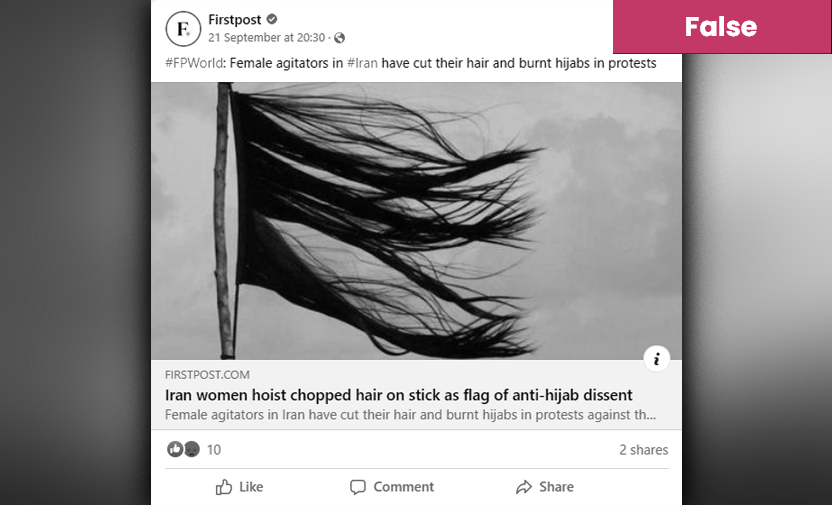
Claim: A flag made of locks of hair waves in Iran in solidarity with a young woman killed by the country’s “morality police” for not wearing her hijab properly.
Fact: The black flag is actually an installation by Belgian visual artist Edith Dekyndt unveiled in 2014.
On 21 September 2022, Indian media outlet Firstpost shared on its verified Facebook page the link to its article about the ongoing feminist protest in Iran, with the caption, “Female agitators in Iran have cut their hair and burnt hijabs in protests against the death of a 22-year-old woman.”
The article, titled “Iran women hoist chopped hair on stick as flag of anti-hijab dissent,” starts with the sentence, “Picture speaks louder than words and an image that is gradually getting viral on social media is a proof to it.” The publication labels it, “Flag of Honour.”
Firstpost posted the article four times — here, here, here, and here — on its Facebook page.
Iran has been rocked by protests over the death of 22-year-old Mahsa Amini, who died after being detained by the country’s so-called ‘moral police’ for allegedly breaking the national dress code for women. Amini’s family believe her death was caused by police brutality while she was in custody.
Fact or Fiction?
Soch Fact Check used TinEye Reverse Image Search to verify the authenticity of the picture and the claim that the flag made of “chopped hair” was hoisted by Iranian women as part of their nationwide protests.
Our search led us to the ‘Announcements’ page of the art publishing platform e-flux, which carries the image of the flag made of hair as its cover photo. It credits the work to Belgian visual artist Edith Dekyndt.
Dekyndt’s official website includes the installation view of her artwork, ‘Ombre Indigène’, shown at the 8-second mark of a video titled “Wiels 2016.”
Another video titled “Wiels.mp4” on her channel Studio Edith Dekyndt shows the same installation from a close-up view. For further confirmation, we checked Edith Dekyndt’s portfolio and found a picture of the installation in it on page 31 as well. The accompanying caption reads as follows:
“Ombre indigène 30 (Part. 2, Martinique), video projection, 16/9, 34’17”, on a loop, 2014. A flag made of hair was stuck in the ground and filmed on top of rocks on the Diamant coast, in Martinique. There, precisely, on the night of 8 April 1830, a clandestine slave boat transporting a hundred African captives washed up on the rocks before being entirely destroyed. Edouard Glissant was buried not far, in the small town of Diamant. Native from this island, this author is at the origin of the ‘tout-monde’ (one-world) and ‘creolisation’ concepts, the later being like an ‘interbreeding producing unpredictability.’”
Virality
Soch Fact Check conducted a CrowdTangle analysis for the 30-day period from 29 August 2022 to 28 September using the following search terms:
- “Iran flag hair woman police”
- “Iran flag hair women”
The first search term turned up 20 Facebook posts that gained 425 interactions, as well as six Instagram posts with 335,871 interactions. The second search term showed 8,179 interactions across 51 Facebook posts, as well as 1,150,671 interactions across 19 Instagram posts.
Indian filmmaker Leena Manimekalai also shared the image, but clarified in a tweet later that it was art and credited Dekyndt. Hindustan Times picked up her tweet and carried a misleading story; the publication, however, did mention that it “could not independently verify the authenticity of the picture”. The report was tweeted out as well.
India Today published the photograph on its website, with the caption, “A flag made with the hair of women would remain as one of the most iconic visuals from the protests.”
On Instagram, the picture was shared by @colinchristian and @siamak_aghaei — both verified accounts. The posts received over 2,300 likes and 16 comments and more than 7,500 likes and 127 comments, respectively. One of the most popular posts was by @alighamsari that garnered upwards of 30,500 likes and 730 comments.
We found three more posts by @ramona_mag, @beafeministgirl, and @kyliereiis.
The image has also become part of graphics such as this and this being posted about the death of Mahsa Amini.
We found that only this Facebook post and another one by the Museum of Private Collections (MoPC) on Instagram correctly mentioned the information, writing, “Symbolic flag of Mahsa Amini” and “Edith Dekyndt’s work became a symbol of the protests,” respectively.
Conclusion: Belgian visual artist Edith Dekyndt’s installation from 2014 has wrongly been portrayed as a flag made of chopped hair on a stick amid protests in Iran over the death of Mahsa Amini.
